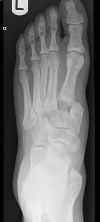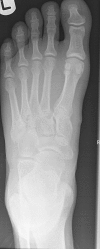The role of reduction and internal fixation of Lisfranc fracture-dislocations: a systematic review of the literature
- PMID: 20683593
- PMCID: PMC2989076
- DOI: 10.1007/s00264-010-1101-x
The role of reduction and internal fixation of Lisfranc fracture-dislocations: a systematic review of the literature
Abstract
A systematic review of the literature was performed in order to evaluate the role of reduction and internal fixation in the management of Lisfranc joint fracture-dislocations. Articles were extracted from the Pubmed database and the retrieved reports were included in the study only if pre-specified eligibility criteria were fulfilled. Eleven articles were eligible for the final analysis, reporting data for the management of 257 patients. Injuries of the first three metatarsal rays were treated by closed reduction and internal fixation with screws in 16.3% of the patients, open reduction and internal fixation with screws in 66.5% and open reduction and internal fixation with Kirschner wires (K-wires) in 17.1% of the patients. The preferred method for the stabilisation of the fourth and fifth metatarsal rays was K-wires. Screw-related complications were common and were reported in 16.1% of the cases. The mean American Orthopaedic Foot and Ankle Society midfoot score was 78.1 points. Post-traumatic radiographic arthritis was reported in 49.6% of the patients, but only in 7.8% of them it was severe enough to warrant an arthrodesis. We conclude that open reduction and internal fixation of the first three metatarsal rays with screws is a reliable method for the management of Lisfranc injuries. This can be complemented by K-wires application in the fourth and fifth metatarsal rays if needed.
Figures






References
Publication types
MeSH terms
LinkOut - more resources
Full Text Sources
Medical

